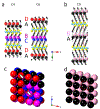XFEL Microcrystallography of Self-Assembling Silver n-Alkanethiolates
- PMID: 37524069
- PMCID: PMC11818436
- DOI: 10.1021/jacs.3c02183
XFEL Microcrystallography of Self-Assembling Silver n-Alkanethiolates
Abstract
New synthetic hybrid materials and their increasing complexity have placed growing demands on crystal growth for single-crystal X-ray diffraction analysis. Unfortunately, not all chemical systems are conducive to the isolation of single crystals for traditional characterization. Here, small-molecule serial femtosecond crystallography (smSFX) at atomic resolution (0.833 Å) is employed to characterize microcrystalline silver n-alkanethiolates with various alkyl chain lengths at X-ray free electron laser facilities, resolving long-standing controversies regarding the atomic connectivity and odd-even effects of layer stacking. smSFX provides high-quality crystal structures directly from the powder of the true unknowns, a capability that is particularly useful for systems having notoriously small or defective crystals. We present crystal structures of silver n-butanethiolate (C4), silver n-hexanethiolate (C6), and silver n-nonanethiolate (C9). We show that an odd-even effect originates from the orientation of the terminal methyl group and its role in packing efficiency. We also propose a secondary odd-even effect involving multiple mosaic blocks in the crystals containing even-numbered chains, identified by selected-area electron diffraction measurements. We conclude with a discussion of the merits of the synthetic preparation for the preparation of microdiffraction specimens and compare the long-range order in these crystals to that of self-assembled monolayers.
Figures






References
-
- Sandhyarani N; Pradeep T, An Investigation of the Structure and Properties of Layered Copper Thiolates. J. Mater. Chem 2001, 11, 1294–1299. 10.1039/B009837J - DOI
-
- Cha S-H; Kim J-U; Kim K-H; Lee J-C, Preparation and Photoluminescent Properties of Gold(I)–Alkanethiolate Complexes Having Highly Ordered Supramolecular Structures. Chem. Mater 2007, 19, 6297–6303. 10.1021/cm7024944 - DOI
-
- Yan H; Hohman JN; Li FH; Jia C; Solis-Ibarra D; Wu B; Dahl JEP; Carlson RMK; Tkachenko BA; Fokin AA; Schreiner PR; Vailionis A; Kim TR; Devereaux TP; Shen Z-X; Melosh NA, Hybrid Metal–Organic Chalcogenide Nanowires with Electrically Conductive Inorganic Core through Diamondoid-Directed Assembly. Nat. Mater 2017, 16, 349–355. 10.1038/nmat4823 - DOI - PubMed
-
- Schriber EA; Popple DC; Yeung M; Brady MA; Corlett SA; Hohman JN, Mithrene Is a Self-Assembling Robustly Blue Luminescent Metal–Organic Chalcogenolate Assembly for 2D Optoelectronic Applications. ACS Appl. Nano Mater 2018, 1, 3498–3508. 10.1021/acsanm.8b00662 - DOI
Grants and funding
LinkOut - more resources
Full Text Sources
Research Materials
Miscellaneous

